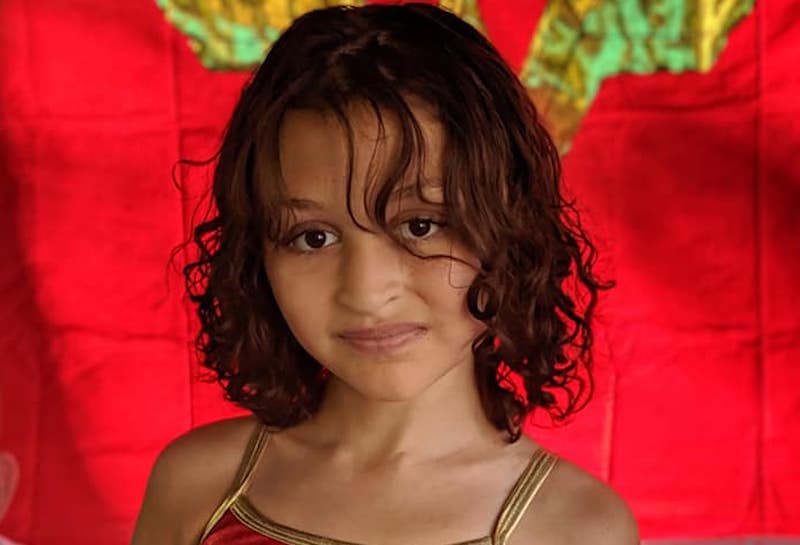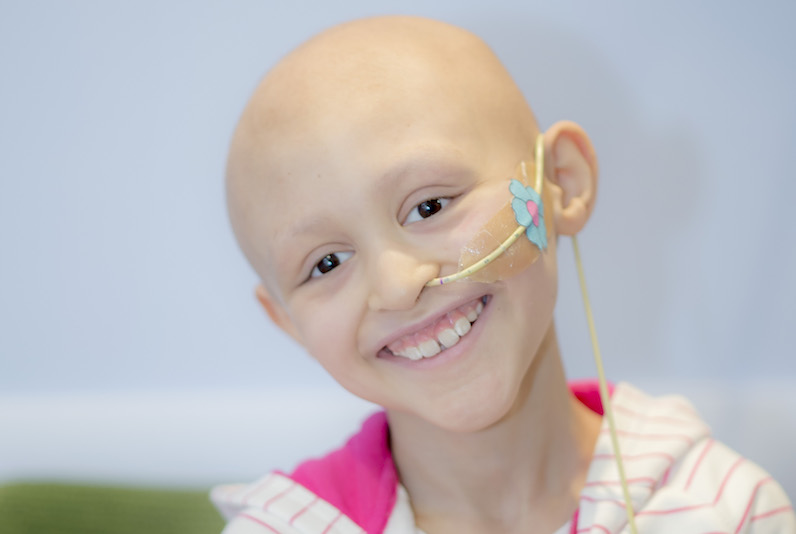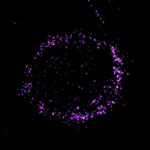Eva rides out the side effects of aggressive Wilms tumor treatment

Eva Quiroz loves horses. The 10 year old takes riding lessons, and this activity puts a smile on her face. Anyone watching her contentedly guiding a horse around the ring would just assume she has always been a healthy child, says her mom Carla. They would see no hint of what Eva has been through over the last few years and how sick she has been.
Determined to beat her cancer
At the age of 7, Eva came down with what her parents thought was a stomach bug. But they soon found out her symptoms were caused by something much worse: a Wilms tumor (a type of kidney tumor) with diffuse anaplasia (this means cells that are aggressive and resistant to treatment). This is the rarest type of Wilms tumor and the most challenging to overcome. When the tumor was discovered, it was stage IV, and the cancer cells had already spread to Eva’s lungs.
“This form of Wilms tumor has a very low cure rate,” admits Dr. Elizabeth A. Mullen, who leads the Kidney Tumor Program at Dana-Farber/Boston Children’s Cancer and Blood Disorders Center. She and Dr. Joelle Straehla coordinated on Eva’s case; Dr. Straehla was a fellow training with Dr. Mullen at the time Eva was diagnosed. Since Eva had been in excellent health before she got sick, Drs. Mullen and Straehla believed they could help Eva beat the cancer by taking an extremely aggressive approach — even though the side effects of the treatment had a high risk of toxicity and would be very hard for Eva to take.
* * *
Tracing Eva’s story
Eva’s story really began three years ago, when she experienced stomach pains and vomiting that was initially believed to be caused by a virus. But a few days later, Carla suddenly noticed a big, hard bulge on Eva’s left side. An initial x-ray revealed a mass (the tumor) on Eva’s kidneys. This finding was confirmed by a CT scan at Boston Children’s.
“One of the oncologists told me that the tumor had likely been hidden under Eva’s ribs until it grew so big that it caused shifting of her organs. He said it was probably the shifting that had caused the pain and vomiting, as well as finally making it noticeable,” Carla says.
Eva underwent surgery to remove the kidney and the tumor it contained along with it.
“The surgery went very well with no complications and Eva recovered quickly,” Carla says. She had expected that Eva’s pathology results (information about the type of tumor) would reveal a standard Wilms tumor, the most common kidney tumor in children, and known for high cure rates. But that was not the case.
An aggressive treatment regime
“When we met with the treatment team, the doctor told us that Eva had a type of cancer that is difficult to cure. I wasn’t able to process anything that followed. I just had this soundtrack repeating in my head: difficult to cure, difficult to cure…” Carla remembers. The anaplasia is present only in about 5 percent of Wilms patients and it meant Eva would need more aggressive treatment.
After surgery, Eva underwent eight radiation treatments and twelve, three-week cycles of chemotherapy, with multiple drugs being administered each cycle, alternating between VDC (vincristine, doxorubicin, and cyclophosphamide), ICE (ifosfamide, carboplatin, and etoposide), and VI (vincristine and irinotecan).

The treatment was so difficult to tolerate that Eva became very dehydrated from vomiting. Her parents quickly learned how to administer IV fluids overnight at home through Eva’s port, which helped her feel better. But the drugs also caused Eva to lose her appetite, requiring her to get a feeding tube that remained for the duration of treatment.
Taking side effects in stride
But through all of the challenges, Eva never lost her good nature, Carla says. She took each setback in stride and just focused on getting well so she could get back to her regular activities again.
“It’s very hard to get through therapy that is this aggressive,” says Dr. Mullen. “But Dr. Straehla stayed by the family’s side to help them through every step of the way, which made all of the difference,” she says. There was also the nursing team, surgical oncologists, radiation oncologist, nutritionists, and child-life specialists. Eva even worked with a speech therapist once when her mouth sores were so bad that she wouldn’t speak.
“Everyone worked together to help Eva get to where she is now,” Dr. Mullen adds.
Offering hope for other children
The good news is that finally Eva made it through the treatment. Now, three years after her diagnosis, she remains cancer-free.
“If you look at her now, she is fabulous,” Dr. Straehla says. “The joy of working in pediatrics is the resilience of children.”
Eva at a riding lesson.
So far, more than a dozen children with stage IV anaplastic Wilms tumor have now been treated with the same type of aggressive approach, and the outcomes have been encouraging. The successes are also providing new hope for other children diagnosed with this type of cancer.
“We are also hopeful since the tumor is so rare that we can study the tissue in children with this disease,” Dr. Straehla says, pointing out that there have been some clinical trials but there aren’t enough cases to learn a lot about this disease. “That’s why Eva’s case is so exciting to us. We want to share her story with others and let people know there is hope,” she stresses.
“When we look at Eva now and see how well she is doing, it’s what absolutely keeps us coming to work every day,” Dr. Mullen chimes in. “We couldn’t do this if we didn’t see the reward. We tell families like Eva’s that we want to see their children grow up and go to the prom, go to college, get married, and someday start their own families.”
Learn more about the Kidney Tumor Program.
Related Posts :
-

A new druggable cancer target: RNA-binding proteins on the cell surface
In 2021, research led by Ryan Flynn, MD, PhD, and his mentor, Nobel laureate Carolyn Bertozzi, PhD, opened a new chapter ...
-

Forecasting the future for childhood cancer survivors
Children are much more likely to survive cancer today than 50 years ago. Unfortunately, as adults, many of them develop cardiovascular ...
-

Pediatric high-grade gliomas: Research reveals effective targeting with avapritinib
Pediatric high-grade gliomas, particularly H3K27M diffuse midline gliomas (DMG), are aggressive malignant brain tumors with a poor prognosis. ...
-

Blood across our lifetimes: An age-specific ‘atlas’ tells a dynamic story
The stem cells that form our blood, also known as hematopoietic stem cells (HSCs), are with us throughout our lives. ...





